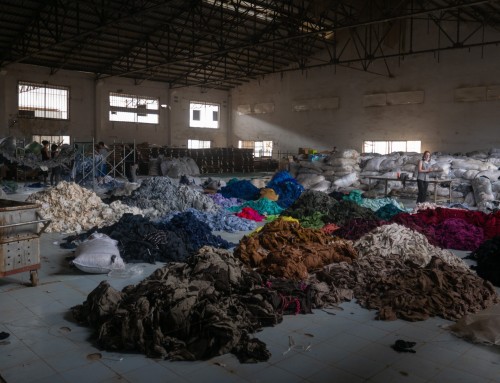This Blog was originally published on the previous Textile Consult site in 2015
The image at the top of this blog could be representative of a number of things…..the resurgence of BRIT pop; recycling garments from vinyl records or any other ideas you want to consider.
From my point of view, the image represents two things that are a huge part of my life: music, (vinyl records in particular) and UK textile manufacturing.
It also represents two industries that have been much maligned and considered as dead by the establishment when, in my opinion, both have been a significant force for those who still follow them.
It’s only in the last few years that some people have taken it upon themselves to try to ‘revitalise’ these areas, even though they were probably doing quite nicely, thank you. The history of the demise and resurgence of both these areas could also be interpreted as closely aligned…
In 1992 various UK high street retailers, and WH Smith in particular, announced that they would be no longer carrying vinyl. In the early years of the CD, many experts pretty much consigned the production and sale of vinyl records to something only read about in history books. Those who remained loyal and still bought vinyl, myself included , were considered old fashioned and not tech-savvy enough for the new formats.
However, one fact was overlooked: the 33’s and 45’s pop music that high street retailers had dropped from their stores were not what the die hard vinyl buying community were buying. Quietly, and without much fanfare, a move to specialist music genres, in particular Acid House and Dance music in the late 1980’s, had meant that the aficionados of this type of music were going underground to independent labels and record stores to make their 12″ purchases.
Mainstream vinyl sales dropped as expected and the media all but forgot that vinyl existed…. but what was considered a dead format, was actually thriving. As early as 2002 The Telegraph was reporting a resurgence of vinyl sales. Fast forward, at 78rpm you could say, to 2015 and the annual Record Store Day is growing year on year; we have the introduction of a vinyl chart; and the format is again considered desirable by the masses. Not bad for a format considered dead 20 years ago.
So what’s the parallel with UK textiles, I hear you ask….?
Well in the late 1990’s, Marks and Spencer and other retailers began moving garment production offshore. This was the move that cost thousands of UK jobs over the next decade, the closures of many British factories and, at the time, was described as a devastating blow for the UK textile industry.
There’s no denying that this was a terrible time for those involved, but despite the enormous impact of the outsourcing, the move offshore was mainly limited to the companies supplying mid level apparel to the industry – M&S, NEXT, Top Shop….the list goes on.
But….and it is a big BUT – the UK textile industry that was involved with the higher end of the market was able to continue and, like vinyl sales, they went about their business largely under the radar.
The worsted industry, for example, has continued to make fine quality suiting for both the UK high street and more importantly, for bespoke tailoring around the world: Yorkshire worsted is still regarded as the ultimate in luxury and quality. The British technical textile market has also continued to grow, particularly in the medical and automotive sectors, and service the world textile market.
As with the vinyl situation, many of these successes were under the radar and largely missed or ignored by the UK media and public. Such is the belief that UK textiles is ‘dead’, that some celebrities and industry professionals have taken it upon them to try and ‘save the industry’.
Initiatives that were not much more than vanity projects, have come and gone. While celebrity led initiatives begin under the spotlight of the media, and with the best of intentions, the ultimate failure and closures of the businesses being ‘helped’ were only mentioned in regional press, if at all. Public interest quickly wanes, in this fast paced world of today.
Other initiatives appear regularly on social media, but again it seems that their impact is limited. While all this is going on, the dedicated professionals and experts in the textile industry are going about their business and doing what they do best: producing quality British products to a loyal and growing client base. Their success is quiet, but not unnoticed and certainly not dead.
So whilst a few high profile high street retailers made some swingeing decisions in the past, which resulted in ‘experts’ declaring the death of both industries, the reality was very different. Both industries undoubtedly suffered some hardships but they survived and started the process of working with their new markets and growing stronger in more specialist and appreciative arena.
2015 is proving to be a good year for both industries and the future looks bright for both textiles and vinyl, but we need to remember that they are on the upward curve because they continued with what they are good at and continued to developed quality products.
Music lovers are returning to the record format and retailers have rediscovered how great homegrown textiles are: you can now buy One Direction on vinyl and you can buy British fabrics on the high street in mid range retailers. This can only be good for both sectors and they should be congratulated for persevering.
The upshot of this article is: these sectors did not need ‘saving’ by outside people, they were perfectly placed to look after themselves and have proved it with their steady and continual progress.
I for one, couldn’t be happier. Vinyl and textiles – here’s to continued British success!


